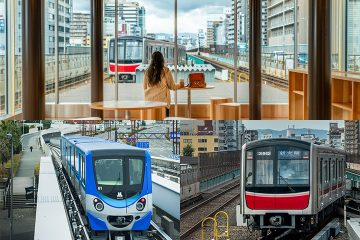SPECIAL
Discover OSAKA
“Along the Osaka Metro Lines” Series:
Sennichimae Line (West)

2021.02.12
Welcome to the fifth issue of “Along the Osaka Metro Line” series where you can discover the characteristics of Osaka Metro lines and the cool neighborhoods that surround them!
Opened in 1969, the Sennichimae Line first operated between Nodahanshin and Sakuragawa Stations and grew into current length of 12.6km between Nodahanshin and Minami-Tatsumi Stations in 1981. It runs directly beneath Sennichimae-dori Avenue, which it was named after, and the line color cherry rose was chosen in the image of bright neon signs found in Namba and Sennichimae area.
Let’s take a closer look at the western part of the Sennichimae Line, between Nodahanshin and Namba Stations!
Connecting with All Osaka Metro Lines
The Sennichimae Line connects with all Osaka Metro lines with the exception of New Tram. A transfer to other lines is made simple—you can connect to the Chuo Line at Awaza, the Nagahori Tsurumi-ryokuchi Line at Nishinagahori, the Midosuji and Yotsubashi Lines at Namba, etc. Every station is equipped with automatic platform gates and the trains are operated only by the driver (there’s no conductor.) The LCD display was first introduced on the Sennichimae Line then installed on Imazatosuji and Chuo Lines.

Desirable Noda Area
Sennichimae Line starts at Nodahanshin Station, where it connects with Hanshin Railway’s Noda Station—the reason why the station name includes “hanshin.” It also connects with JR Tozai Line’s Ebie Station here. There’s another Noda Station nearby—this one is on the JR Osaka Loop Line—which is connected to Tamagawa Station, the next stop on the Sennichimae Line.
In front of Nodahanshin Station is a large intersection and residential areas stretch out beyond. Easy access to other parts of Kansai—to Umeda, Namba, Kobe, Kyoto, and Nara—and the ambience of a good old shitamachi make this area a desirable neighborhood to live. Behind the Nodashinbashisuji shotengai shopping street is an area known as “jigokudani” (literally “hell valley”,) a true gem of Kansai that only the insiders know, where tiny six-seater old school bars and restaurants clutter around narrow alley ways.


Located between the next two stations, Tamagawa and Awaza, is the bustling Osaka Municipal Wholesale Market Honjo. While the name says “wholesale,” the market caters to everyone and you can savor fresh seafood at its many seafood restaurants and enjoy the popular tuna dismantling and carving show usually held in November. Along the river on the south side of the market by the small marina is Nakanoshima Gate Park where you can have a barbeque.


An Island Turned Center of Arts
At the next stop, Awaza, you will notice various pieces of art decorating the walls from the ticket gate to the station exit 8. This is thanks to the nearby Enokojima Art, Culture and Creative Center, a center of arts and culture that opened in 2012. Affectionately known as “enoco,” the Center holds unique events and workshops that’re worth checking out.
The Enokojima area used be an island surrounded by three rivers. While two of the three rivers have been reclaimed and there no longer is an island, the geographic history of the area remains in its name Enokojima, which literally means “Enoko island.”
Tsunami and Storm Surge Disaster Prevention Station next to enoco is a great place to visit, where you can learn about the intensity of earthquakes and tsunami and how to best protect yourself from these powerful natural phenomena.


The History Behind Local Names
One of the largest municipal libraries, Osaka Municipal Central Library, is located next to Nishinagahori Station. It boasts a large collection of books on Osaka’s history. Speaking of history, during the Edo period (1603-1868,) the Tosa Domain (a feudal domain of Tokugawa Shogunate based at today’s city of Kochi on the Shikoku island) set up its warehouses and sales offices called kurayashiki in this area to sell their local products. You can still see the impact of their existence in the area—local intersections “Shiragabashi” and “Katsuozabashi” were named after Mt. Shiraga in Tosa and Tosa’s local specialty katsuo (bonito) and merchants from Tosa took residence in the “Tosabori” neighborhood. The Mitsubishi Group was founded in this area by Iwasaki Yataro who was originally from Tosa. You can find a stone monument on the grounds of Tosa Inari Jinja Shrine where Iwasaki’s house once stood. The shrine is also famous for its sakura cherry blossoms since the Edo period.


After Sakuragawa Station, you reach Namba Station, the center of Osaka’s minami. You can find the origin of the name Sennichimae, a famous entertainment district in Minami, in this area. Hozenji Temple—where many visit to splash water on the mossy Mizukake Fudo-san statue—was once also known as “Sennichi-dera” because it was a place for chief monks of Buddhist temples to perform “Sennichi Nembutsu” where they prayed and trained for one thousand days. Because of this tradition, the area around the temple was named Sennichimae (literally “in front of Sennichimae.”)


You can transfer to the Midosuji Line at Namba; check out the neighborhoods around the Midosuji Line here
“Along the Osaka Metro Lines” Series: The Midosuji Line (North)
Look out for the next issue that’ll cover the eastern part of the Sennichimae Line (Nippombashi to Minami-Tatsumi)!
Recommended Plans

Where to Stay in Osaka: Umeda, Namba, Shinsekai Area Guide
Are you contemplating a trip to Osaka? Or maybe Osaka is already on your list of places to visit. …
2025.05.02

“Along the Osaka Metro Lines”
Series:《The Chuo Line West》
Here’s the issue two of the series that introduces the characteristics and charms …
2025.04.11

#TravelThruPhotos
Best Photography Spots on Osaka Metro: Trains
The colorful train cars of Osaka Metro attract railway enthusiasts and others to take …
2023.08.25






